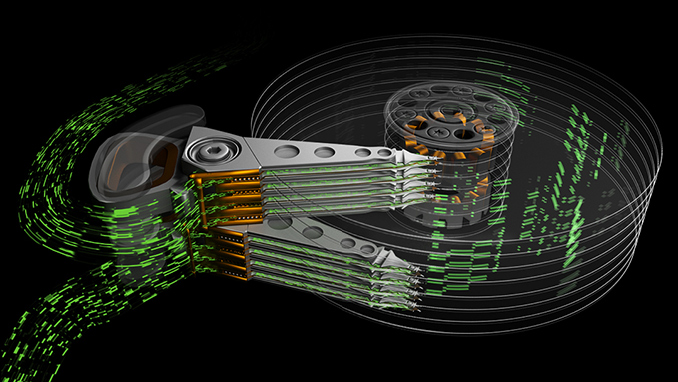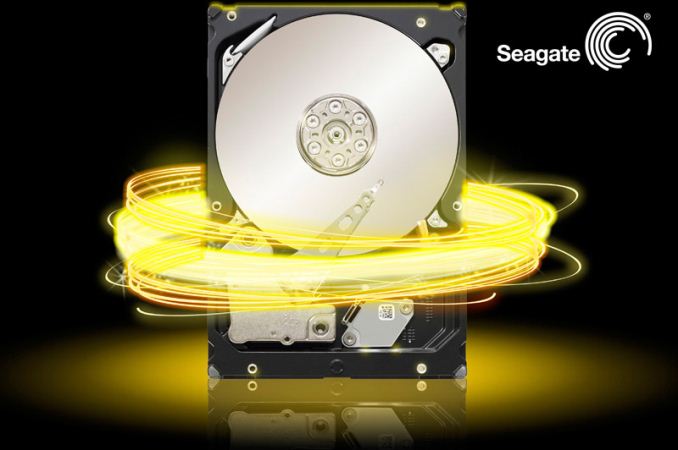Seagate’s Multi Actuator Technology to Address HDD IOPS Woes
by Anton Shilov on December 29, 2017 12:01 PM EST
Seagate introduced its new Multi-Actuator Technology (MAT) for hard drives earlier this month. It promises to increase hard drive performance by using two or more sets of actuator arms that operate independently from a single pivot point. Seagate claims that next-gen HDDs will require higher performance to effectively take advantage of their increased capacities. It plans to use MAT in their datacenter hard drives going into pilot production in 2018.
To improve the performance of next-generation hard drives, Seagate proposes to install not one, but two (or more) sets of actuators into a single HDD. The actuators are to be equipped with their own arms/heads as well as magnets to position them, but will use one pivot. As a result, the actuators will be able to act completely independently, essentially creating parallelism within a single hard drive. With an architecture like this, IOPS performance will scale with the number of actuators. Aggregate read/write performance of hard drives will also increase, but since it will depend on many factors, it is too early to make predictions regarding throughput of next-gen HDDs. The additional components required for two independent actuator assemblies (and a considerably more sophisticated HDD controller) will make such hard drives more expensive to build when compared to today’s models. This could be one of the reasons why Seagate plans to use its Multi-Actuator Technology only for hard drives designed for datacentres, where hardware costs are not as crucial as performance and features.
The first-generation MAT-enabled HDDs are to use two actuators operating on a single pivot point (along with 8 platters and 16 heads), but going forward the number of actuators may grow. Seagate says that the host computer can “treat a single Dual Actuator drive as if it were two separate drives”, but stresses that logically the HDD will remain a single device with two access streams for communication, just like dual-port SAS drives do. Meanwhile, Dual Actuator HDDs will be able to use not only SAS, but also NVMe and SATA interfaces. In the best-case scenario, a hard drive with two actuators can double the random read/write performance and almost double the sequential read/write performance compared to today's hard drives. The sequential access case is a bit tricky, since the cylinder height gets halved with two actuators, and a lot depends on how the addresses are translated to the actual physical sectors.
The arrival of new magnetic recording technologies in the coming years will significantly increase capacities of hard drives for cloud/exascale datacenters to over 20 TB by 2020 and to 40 TB within the next five or seven years. The upcoming HDDs will increase their sequential read/write performance along with the increase of their areal densities, but when it comes to latencies and random read and write operations, things get more complicated. The current HDD architecture uses a single actuator that synchronously moves all the arms with read-write heads over the media together for reading and writing data. With such an architecture, the platters can only work on one request at a time. Meanwhile, the more data an HDD stores, the more requests it gets and the more time it spends seeking the right track/sector. If/when fulfilling a request takes too long, quality of service (a metric dear to datacenter operators) suffers. Today, the performance bottleneck is solved by using either NAND flash or multiple hard drives in parallel, effectively combining their performance for certain access traces. At some point, this approach may become inefficient due to power/complexity and other factors. Therefore, it is imperative that HDDs get faster in order to cope with tomorrow’s workloads.
Seagate says that the Multi-Actuator Technology is to be deployed on products in the near future, but does not disclose when exactly. As the company’s blog post on the matter mentions both MAT and HAMR, it is highly likely that commercial hard drives featuring HAMR due in late 2019 will also have two actuators on a single pivot. At the same time, it does not mean that the MAT is not going to find itself a place in products using conventional PMR.
Related Reading
- Western Digital Stuns Storage Industry with MAMR Breakthrough for Next-Gen HDDs
- Toshiba Announces 14 TB PMR MG07ACA HDD: 9 Platters, Helium-Filled, 260 MB/s
- Toshiba Commercializes SDK’s 9th Gen PMR, Tech Enables 14 TB PMR HDDs in 2018
- Western Digital Now Shipping 14 TB HDDs: HGST Ultrastar Hs14 with 1000 Gb/in2
- Western Digital Announces Ultrastar He12 12 TB and 14 TB HDDs
- Seagate Announces Enterprise Capacity 12 TB HDD: 2nd-Gen Helium-Filled Hard Drives
Source: Seagate











88 Comments
View All Comments
mode_13h - Friday, December 29, 2017 - link
99% perspiration, dude. The idea is usually the easy part. Probably tens of thousands beat you to it.shabby - Friday, December 29, 2017 - link
If the platters would spin independently then we'd have a winner but since we don't then the performance numbers will always say "up to twice as fast". And in some instances just as slow as a regular hd.mode_13h - Friday, December 29, 2017 - link
What on earth would that solve? HDDs are normally constant velocity, you know. Significant variation of rotational speed would burn a tremendous amount of power.FunBunny2 - Friday, December 29, 2017 - link
"HDDs are normally constant velocity"angular velocity, of course. which is why, some decades ago, hard formatted PC drives started to have variable sector boundaries to take advantage of greater density on the edge-ish tracks.
cjl - Friday, December 29, 2017 - link
What would be solved by independent platter spin? No matter how many heads are active at once, you still want minimal variation in rotational speed.Bullwinkle-J-Moose - Friday, December 29, 2017 - link
"Why do we care about how fast an SSD copies data on itself? Is this really a bottleneck for any common use cases?"-------------------------------------------------------------------------------------------------------
Simultaneous Read/Write speed to and from an SSD can be easily tested by this method of Copy and Paste
or to put it another way.....
Why then would we care if this new Seagate HDD attempts to do the same thing at much slower speeds than an SSD ?
FunBunny2 - Friday, December 29, 2017 - link
well, the engineering does work:"Read/write heads were fixed in position over each track. That eliminated seek time and contributed substantially to system performance. Data could be written at rates up to 3 million bytes per second."
here: https://www-03.ibm.com/ibm/history/exhibits/storag...
not bad performance for 1970
Beaver M. - Friday, December 29, 2017 - link
Before I buy a HDD like that, I will wait quite some time until its known how reliable they are. Added complexity always nibbles on reliability, especially when its something like this.mode_13h - Friday, December 29, 2017 - link
Sure, but are you running a database server or something? What kind of high-IOPS workload do you have that would justify the additional cost, power, and (as you point out) potentially lower reliability?They said these are targeted at datacenter customers, so I wouldn't be looking to jump on them for home use.
Beaver M. - Saturday, December 30, 2017 - link
It was a general statement.